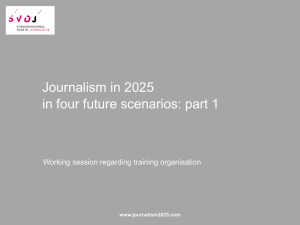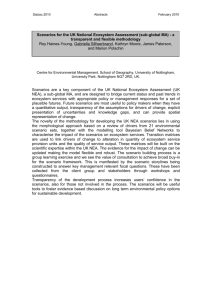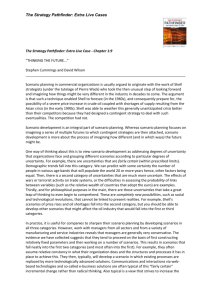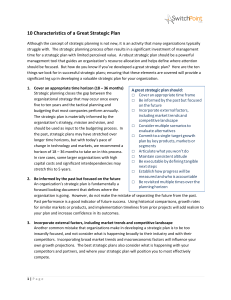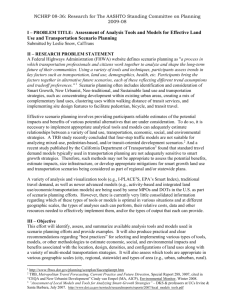toolkit - The journalistic landscape in 2025
advertisement
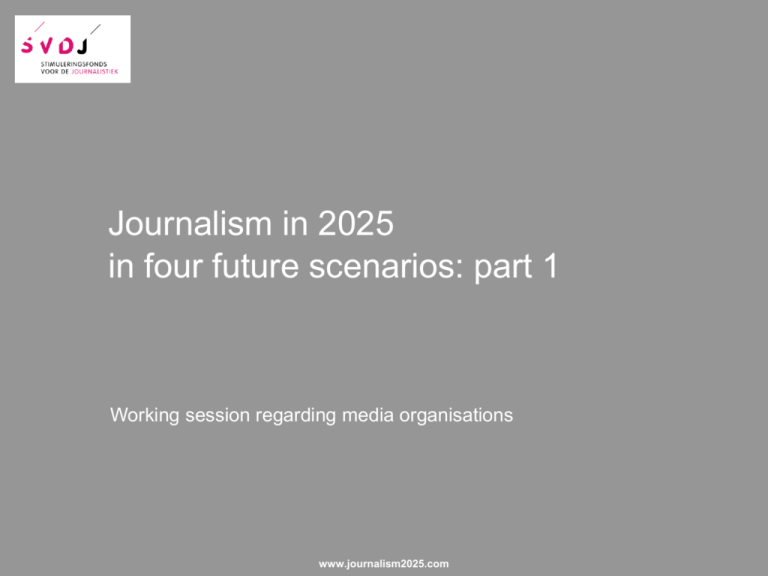
Journalism in 2025 in four future scenarios: part 1 Working session regarding media organisations www.journalism2025.com Structure of this presentation • This presentation consists of three parts - the first two parts are for the workshop and the last part is for the workshop facilitator. Please read this presentation thoroughly if this is the first time you have facilitated this workshop. • Part 1: explanation of the scenario research for use during the workshop • Part 2: Working with the scenarios within your training program • Part 3: instructions for the workshop facilitator www.journalism2025.com SVDJ research into the future of journalism Research was carried out in an interactive process with more than 150 journalists, scientists, publishers, directors, editors, educators and philosophers. The result was: • A report to help government have a political debate about the future of journalism • www.journalism2025.com: a website that presents trends and scenarios clearly and gives clarity to the changes • Roadmaps for working sessions about the scenarios so that journalists and journalistic organisations are assisted in their renewal efforts www.journalism2025.com How were the scenarios developed? • Trends were collected and analysed • Trends with the greatest impact were selected • Fundamental uncertainties were set against each other • After which, greatly differing potential futures emerge NB When there is a reference to a page number in this presentation, it refers to the SVDJ report, Otherwise, any news? When we refer to slides, we mean this PowerPoint presentation www.journalism2025.com What are scenarios? • Fictional stories about the future • They describe the world around you: - that which you cannot influence - but which has a significant impact on journalism • A thinking experiment: what if the world were to look like this? www.journalism2025.com What do you get from scenarios? • A better understanding of a complex world • Earlier recognition of important developments • Fewer surprises • Help to define a strategy • Placing a sharper focus on the strategic challenges facing your company/publisher www.journalism2025.com Looking at the trends: Trends in the study are divided into: • Leading, independent trends: social and technological developments with great influence on journalism • Dependent trends: trends within journalism itself The extent to which the both the steering, independent trends, as well as the dependent trends, can be determined accurately (see p. 24). www.journalism2025.com What the participants in the scenario project are convinced will happen: • Disruption to revenue models: subscriptions, single copy sales, advertising • Smart devices and social media changing the playing field • New consumers behaving fundamentally differently: simultaneous consumption, news snacking, references to source materials, Martini principle (consumers wanting news 'anytime, anywhere') • Reduction of reading time • News consumer in the centre: on demand is the future • Loss of interest in titles: unbundling, references, self publishing • Opportunities for non-traditional news providers • Images become increasingly important www.journalism2025.com What the participants in the scenario project are sure will happen: The internet of things Media use is ambient: ubiquitous, embedded and adaptive Algorithms steer the consumption of news Bandwidth growth creates more opportunities for images • Public trust in journalism falls • The importance of transparency and the accountability of journalists increases • The citizen as a journalist? • The power of change within traditional journalism organisations is too low? www.journalism2025.com What raises more questions and is still uncertain: • Smarter use of personal details vs. privacy violation? • Technology creates market power: impotence of governments concerning the power of technology giants? Future cuts to public broadcasting? De-centralisation creates more demand for local news? • Institutional versus individual(s): control versus selforganisation? • Sharing economy? • Widening gap in society? www.journalism2025.com The scenarios vary: 1. To what extent are technological innovations accepted? 2. Will consumers take the initiative to satisfy their needs or do they expect brands and (government) institutions to do that for them? www.journalism2025.com What can we do? What are we allowed to do? What do we want to do? acceptance of technology radical reluctance www.journalism2025.com benefits of new technologies are felt far and wide technology is very user-friendly good return on investment digital and mobile technology = the future discussion about the pace of development, the extent to which everyone participates and safety. increasing awareness of links between technology, market power and divisions in society Who do we trust? How do we arrange things? Who takes the initiative? do-it-yourself do-it-for-me social trust take our own initiative trust our peers more opportunities to settle matters themselves cut-out-the-middle-man crowdfunding & sourcing Initiative by brands & government trust in institutions, companies, brands convenience & time savings & clarity strength and decisiveness of institutions, guarantees transparent government and institutions www.journalism2025.com radical do-it-yourself acceptance of technology Wisdom of the crowd A handful of Apples do-it-for-me social trust Darwin's Game The Shire reluctance www.journalism2025.com • Economy and society dominated by precocious inventors, start-ups and virtual collaborations: new initiatives appear and disappear rapidly • A strong do-it-yourself mentality: co-creation, sharing and crowdfunding make large breakthroughs. The role of government is small. • Influence of Google and Facebook et al is greatly diminished: aversion to privacy violation & market power • The decision about what news is no longer determined by media brands, but the crowd. Journalists are primarily a collector, curator and community manager do-it-yourself (diy) radical acceptance of technology Wisdom of the crowd trust do-it-for-me (difm) www.journalism2025.com reluctance A handful of Apples acceptance of technology radical • A handful of mega-corporations increasingly determine the economic, social and political agenda. • The CEOs of Ali Baba, Apple, Google and Rosneft are more powerful than many heads of state. Many smaller players are taken over or have to make way. • Hardware, software, physical products, content: everything is branded and offered via integrated chains, which is also true for most of the news. • News is personalised: push-info • Niche for quality journalism. Most traditional media companies have not survived. A few do their best to retain their independence, but the bulk of the population considers this to be an uninteresting rearguard action as long as people get exactly what they want do-ityourself (diy) trust reluctance www.journalism2025.com do-it-for-me (difm) radical The Shire social trust do-it-for-me (difm) • Small-scale, self-reliance and caution are important societal values. The caring government has largely pulled away. One's own district and region are the new anchor points. • Continuous search for like-minded people in different communities • Cybercrime and privacy violations: the general opinion is that technology needs to be handled with extreme caution • The media landscape is an archipelago of small titles. Many journalistic newspapers and magazines have been stopped. • Thematic community sites to which both citizen journalists and professionals contribute. Mostly local focus. Sometimes only echo rooms acceptance of technology do-ityourself (diy) reluctance www.journalism2025.com radical do-ityourself (diy) Acceptance of technology Darwin's Game do-it-for-me (difm) • Institutions win back the trust of their original public. They show themselves more transparent and accessible; in dialogue. • The journalistic landscape is evolving: a number of traditional news bringers succeed in making their brands relevant again, and to curb the explosive fall in viewers and subscribers. Others are too slow and fall by the way-side. Wide variation in the way news is offered and reported. • Traditional media companies significantly change their structure through efficiency savings, close cooperation and continuously experimenting with business models. • The public expects journalism to prove itself over again, makes high demands and is not loyal to specific brands reluctance www.journalism2025.com Part 2 Working with the four scenarios Working session regarding media organisations www.journalism2025.com The scenarios can be looked at from three perspectives • Perspective 1: Implications of the scenarios, and exploring and recognising options for action. • Perspective 2: Checking of current plans & implicit/explicit strategies. • Perspective 3: Explore opportunities to influence the scenarios www.journalism2025.com Perspective 1: Implications of the scenarios, and exploring and recognising options for action • Implications of the four scenarios and projecting one's own company/organisation/function • Options for action in 2015 and 2025 www.journalism2025.com Perspective 1: implications • Take yourself to 2025... • Immerse yourself in one scenario at a time and imagine that you have relevant training/experience in 2025. (whether you agree with the scenario is irrelevant) • Determine the consequences of each scenario for journalism & the media sector as a whole • Which of the existing beliefs for this time (2015) are outdated in this scenario? www.journalism2025.com Perspective 1 Implications for media companies What are the implications per scenario for: • Current business models • Titles in the portfolio • Genres that can be successful • The required competencies of employees • Establishment of your company • Takeovers and/or collaboration partners www.journalism2025.com Perspective 1: options What are the options for action in each scenario? 1. What things that you are currently doing would you most likely have to reduce or even stop (the most difficult!) 2. What new things would you have to start or increase the tempo of (the nicest!) 3. What does that mean for the commitment of resources (manpower, money, systems) www.journalism2025.com Perspective 2: cleaning out existing strategy • Checking current plans & strategy • Concrete actions! www.journalism2025.com Perspective 2: Clean-out If we take our existing visions, implicit and explicit strategies & plans and expose them to the 'storm force' of a scenario: • What is the extent of the damage caused to our existing plans in all four scenarios? • What are the risks, threats and opportunities in each of the four scenarios and to what extent are they covered by the current plan? • Read paragraph 5.3 (pages 36 and 37): to what extent does the current strategy address the strategic challenges for journalism described here? www.journalism2025.com Perspective: concrete actions! Options, monitoring and 'clean-out' requirements for all three concrete actions. What are they? • For the upcoming quarter? • For the coming year? • For the coming 3 years? www.journalism2025.com Perspective 3 Desirability of exploring the scenarios & possibilities to influence research www.journalism2025.com Perspective 3: questions posed by the scenarios • • • • Which scenario do you deem most likely and why? Which scenario do you prefer and why? Which scenario do you fear and why? Can you see any opportunities for you to promote a scenario, whether or not it becomes reality or not? • How can you increase the intervention capabilities (think for example of promoting collaboration) www.journalism2025.com Part 3 Practical use of the handbook with scenarios Working session regarding media organisations www.journalism2025.com Explanation This presentation can be used to support your use of the scenarios to explore the future of journalism and your role in it. The most fruitful approach is to do that during either one or several working sessions and a mixed group. We advise you to appoint 1 person to act as the facilitator of the working session. In some places the slides contain notes for the facilitator of the working session. NB When there is a reference to a page number, it refers to the SVDJ report, Otherwise, any news? When we refer to slides, we mean this PowerPoint presentation www.journalism2025.com Preparation of the working session (1) Reserve at least 2.5 hours for the working session Think carefully about the composition of the group. Often, the best result come from a mix of ages, experience and expertise. For example: journalists, publishers, freelancers, as well as marketing & sales. All participants should read the SVDJ report in advance (available for download from www.journalism2025.com). The facilitator should take the following materials for attendees: • the summary from the report for all participants (p. 4 & 5); • overview of the trends (p. 24) • short descriptions of the scenarios (p. 28) The facilitator should read this presentation and make adjustments as required (see next slide) www.journalism2025.com Preparation of the working session (2) This presentation provides a brief summary of the process of the scenarios, describes the value of the scenarios and introduces the four different scenarios. There are then three different ways in which the scenarios can be used (in this presentation, we call these three perspectives). You can choose one, or do all three. If you choose to do just one, we advise perspective 1 because this is the core of scenario thinking: experiencing the future before being required to make informed choices. www.journalism2025.com



